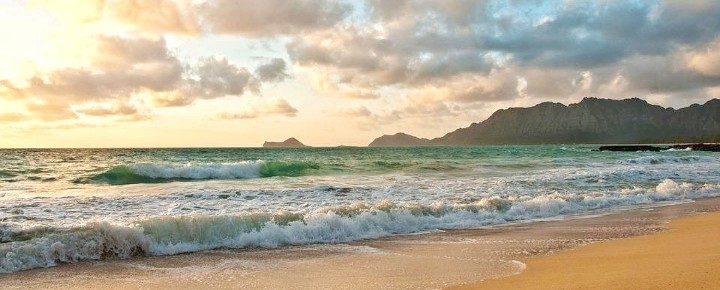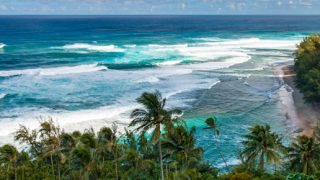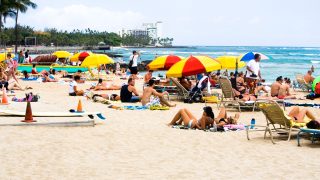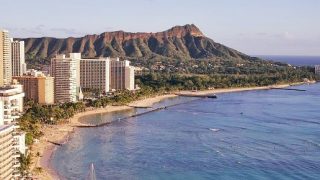Hawaii visitors are set to receive an education on arrival in Hawaii, whether they want to or not. Is this good or bad? But this is just the beginning of what’s in store as the more controversial aspects of Hawaii’s Destination Management Action (DMAP) Plans begin. And how do you feel about geotargeting and geofencing. Those are coming to Hawaii tourism, too, as you’ll read below.
UHERO, the University of Hawaii research arm for the state, takes a rather critical take on HTA and the DMAP. They’re concerned that Hawaii Toursim Authority’s (HTA) controversial plans don’t have either the backing of the state or the authority needed to ever be implemented. But the contentious HTA appears to be moving full speed ahead nonetheless.
On a lighter note, their latest messaging about “Pono” travel tips and “Malama Hawaii” is set to be prominently featured on your next Hawaii vacation. Expect to see these presented in baggage claim and public areas at all of the island airports and many other places.
The HTA’s goal for these videos is to be “connected with visitors on every leg of their travel journey – from the planning stages, in transit, upon their arrival, and throughout their stay,” according to its press release.
Wow, that makes it sound like you’re going to be followed.
“We are doing everything we can to communicate the right message to our visitors…Through various media platforms, over time we hope to see a shift in how travelers engage with our communities and home.”
Geotargeting and Geofencing: Hawaii tourism marketing’s new buzzwords.
HTA said this about some of their new technologies: “This form of post-arrival outreach enables us to use geotargeting technology (and) targeting zip codes with an above-average composition of visitors, as well as geofencing which identifies mobile devices within designated visitor hot spots on each island. Therefore, we can continue to share our pono travel messaging with the right people at the right time.” Huh?
If you’re not familiar with it, geofencing lets you market to a target audience based on where they are located. It’s a type of location-based technology wherein you connect with smartphone users in a contained geographic area, such as in specific tourist areas, typically communicating through mobile apps or websites. It uses Wi-Fi, GPS, Bluetooth, etc. Now how they’ll use geofencing, and how they’ll share “pono travel messaging with the right people at the right time, remains to be seen.
And, by the way, for those visitors using Waze mapping instead of Google Maps, HTA’s messaging will also be served to you there.
Controversial Hawaii Destination Management Action (DMAP) Plans.
This new outreach is just one small part of what’s upcoming at HTA. They’ve developed island-by-island plans. The Oahu DMAP states, for example, that, “the visitor industry will be rooted in mālama — to take care of this place and each other. Oahu will live in joy, abundance, and resilience because visitors and residents understand what is pono, and have respect for each other and the environment.”
An admirable vision. At the top of the Oahu plan is simply a reduction in the number of tourists.
Following that, Oahu’s plan calls for a “Regenerative Tourism Fee (which) directly supports programs to regenerate Hawaii’s resources, protect natural resources, and address unfunded conservation liabilities. In other words, so-called “green fees,” in one form or another, are coming to Hawaii.
UHERO is not so sure.
Among other things mentioned by UHERO is that the Oahu plan wants to “decrease the total number of visitors to Oahu to a manageable level by controlling the number of visitor accommodations and exploring changes to land use, zoning and airport policies.”
UHERO states, however, “we are not convinced that HTA can achieve this or many of the other actions because they lie beyond HTA’s capacity… We set aside for another day a discussion of whether reducing the number of visitors would actually be good for the community.”
Hawaii has been crafting tourism plans for more than forty years. However, as UHERO also pointed out, “until now, the State’s policy toward tourism has been to accommodate its growth. With HTA’s new [plans]… that is about to change!”
Beat of Hawaii: We’d add to the concerns, the sense that visitors to Hawaii are already tending to feel marginalized in a multitude of ways including Hawaii’s highest accommodation taxes, new visitor-only fees, skyrocketing prices, and the general concern about being welcome. Valuing visitors never seems to play a significant role in HTA messaging.
Also, the HTA is conflicted when it is talking about reducing visitors to Oahu. Its chief brand officer was recently quoted as saying “if people aren’t coming, then we’re not doing our job.” It is, after all, the job of the HTA to promote tourism.
HTA’s lastest “Hawaii Is Our Home.”
HTA released another in its Malama Hawaii series entitled “Hawai‘i Is Our Home,” which is being shown to visitors on-island via social media targeting. That video is intended to reinforce “reciprocal responsibility” such that visitors learn to protect Hawaii’s wildlife, natural resources and community.
Promote more Hawaii tourism or reduce it?
We aren’t sure how you can have it both ways, as appears to be the case at HTA. At least not successfully, and without, as you’ve said countless times in the comments, biting the hand that feeds you. How do you feel about geotargeting and geofencing and other latest strategies designed to manage Hawaii tourism?







Randy,
My trial run lasted about 3 or 4 years. But she and we get along quite well. We have stayed with her in Texas and she with us.
That’s a lot of trips to Hawaii! I have govt business here, but it’s hit and miss. This year I sent a crew over for 4 days of work and 4 days of sun and sand.
Glad your brother made it home! If he was in Vietnam in 68/69 he probably endured Tet. The media and America last crowd got that all wrong. Sure, it was a surprise, but after Tet the VC were finished -they, not us, suffered devastating losses.
We have 2 weeks planned in September – Waikiki as usual.
Semper Fi to Kev!
Hawaii is extremely expensive. The native population is unfriendly and unwelcoming. Despite that We have been visiting the beautiful islands continually for 20 plus years. If these new tourist ideas and fees are implemented we will have made our last trip. Period.
B & P, Las Vegas
Donʻt take my reply the wrong way… Iʻm only responding to your comment But, if you feel like Hawaii is too expensive, you need more money or you should try another destination. If you feel the “natives” are unwelcoming and unfriendly, you could ask yourself why? Personal direct experience? Overall atmosphere? Does it make you doubt the feeling of aloha? Itʻs a very subjective thing, but I can say you would be in the minority of visitors who believe so but again, try another destination with more “welcoming and friendly natives”. If you have been visiting for 20+ years and don’t understand the need for new fees, new regenerative tourism, and new attitudes by visitors, you definitely should find another destination: Cancun, Bahamas, PR.
While some visitors definitely need to be educated there are a few locals that could probably benefit from some educating too. Let’s be honest. If all the programs targeted at visitors only were aimed, at least in part, at locals as well they would die a very rapid death.